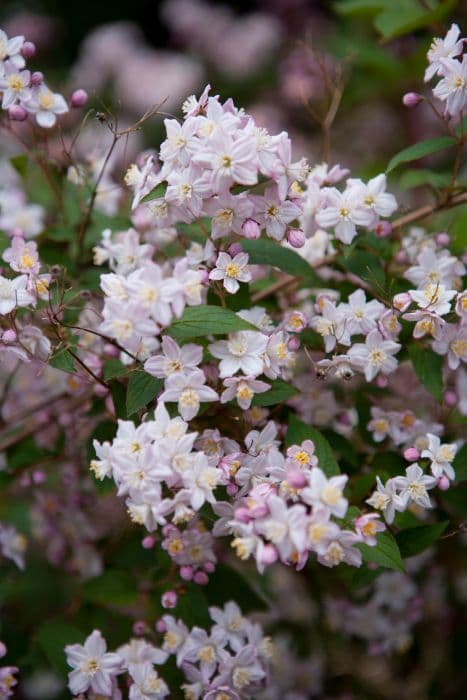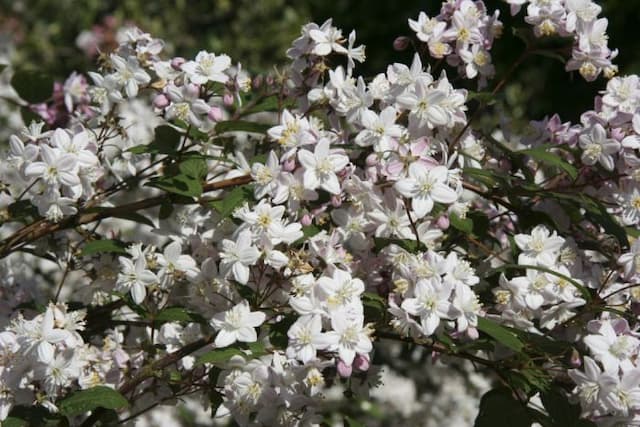Rough-leaved hydrangea Hydrangea aspera 'Macrophylla'

ABOUT
The Hydrangea aspera 'Macrophylla', commonly known as the rough-leafed hydrangea, features large, velvety leaves that are broad and have a textured surface. These leaves boast a rich green color and can provide a lush backdrop for the striking flowers. The plant is well-known for its distinctive blooms, which appear in large, rounded clusters. The flower heads are a combination of small, fertile flowers and larger, showier sterile flowers, which together create a mophead effect. These blooms exhibit shades that can vary from pink to violet, and sometimes blue, depending on the soil's acidity. The flowers are known to attract pollinators and can add a touch of visual interest to any garden. The rough-leafed hydrangea has a bushy appearance, making it an excellent choice for borders or as a specimen plant. Its large leaves and vibrant blooms give it a presence in the garden throughout the growing season.
About this plant
 Names
NamesFamily
Hydrangeaceae
Synonyms
Rough-leaved Hydrangea, Velvet Hydrangea, Hairy Hydrangea
Common names
Hydrangea aspera 'Macrophylla'.
 Toxicity
ToxicityTo humans
Rough-leaved hydrangea (Hydrangea aspera 'Macrophylla') is considered to have low toxicity to humans. However, the plant contains compounds such as hydrangin, which is a cyanogenic glycoside. Ingesting parts of the plant can lead to the release of cyanide in the body. Symptoms of poisoning may include nausea, vomiting, stomach pain, diarrhea, and in severe cases, difficulty breathing, dizziness, or fainting due to potential cyanide toxicity.
To pets
Rough-leaved hydrangea (Hydrangea aspera 'Macrophylla') is also toxic to pets, including dogs and cats. Just like in humans, the plant contains cyanogenic glycosides that can release cyanide when ingested. Symptoms of poisoning in pets may include gastrointestinal upset, such as vomiting and diarrhea. More severe symptoms could include lethargy, depression, confusion, increased heart rate, and breathing difficulties. If a pet is suspected to have ingested parts of the plant, immediate veterinary care is recommended.
 Characteristics
CharacteristicsLife cycle
Perennials
Foliage type
Deciduous
Color of leaves
Green
Flower color
Mixed
Height
10 feet (3 meters)
Spread
10 feet (3 meters)
Plant type
Shrub
Hardiness zones
7
Native area
Asia
Benefits
 General Benefits
General Benefits- Attracts Pollinators: Hydrangea aspera 'Macrophylla' flowers provide nectar and pollen for bees and other beneficial insects.
- Aesthetic Appeal: With its large leaves and showy flower heads, it can be a centerpiece in gardens, enhancing the landscape's visual interest.
- Shade Tolerance: This plant can tolerate lower light levels, making it suitable for planting under trees or in shadier garden spots.
- Erosion Control: The extensive root system of the Hydrangea aspera 'Macrophylla' can help to stabilize soil on slopes and prevent erosion.
- Seasonal Interest: It adds color and texture to the garden throughout the seasons, with blooms in summer and sometimes attractive fall foliage.
- Wildlife Habitat: Provides shelter and breeding spots for small wildlife due to its dense foliage.
- Low Maintenance: Once established, it requires minimal care other than occasional pruning and watering during extreme drought.
 Medical Properties
Medical Properties- This plant is not used for medical purposes.
 Air-purifying Qualities
Air-purifying QualitiesThis plant is not specifically known for air purifying qualities.
 Other Uses
Other Uses- Creating a wildlife habitat: Hydrangea aspera 'Macrophylla', with its wide, dense foliage, can serve as a natural shelter for birds and small animals seeking refuge or nesting space.
- Crafting dried flower arrangements: The flowers and foliage of the Hydrangea dry well, maintaining their shape and color, making them excellent for long-lasting, ornamental displays.
- Educational tool in botany studies: Due to their interesting reproductive parts, Hydrangeas can be used by schools or educational programs to demonstrate plant biology and pollination mechanisms to students.
- Color-changing experiment subject: The flowers of the Hydrangea can change color based on soil pH, making it an intriguing candidate for experiments in gardens or in educational settings.
- Photography prop: The large, attractive blooms of the Hydrangea make it a popular subject for garden photographers and for use in outdoor portrait backgrounds.
- Informal hedges or privacy screens: Because of its large size and dense growth, Hydrangea aspera 'Macrophylla' can be used to create semi-private spaces in gardens or yards.
- Erosion control: The extensive root system of the Hydrangea can help stabilize soil on slopes and prevent erosion in certain landscape situations.
- Theme gardens: Hydrangeas can be featured in moon gardens due to certain varieties that have pale or silver-tinted foliage that reflects moonlight or in a Victorian-themed garden due to their traditional use in that era.
- Incorporation into texture gardens: With its rough leaves and velvety texture, Hydrangea aspera 'Macrophylla' is perfect for a sensory or tactile garden experience.
- Culinary decoration: Although not edible, Hydrangea blooms can be used as a non-toxic decorative embellishment for cakes and dessert presentations.
Interesting Facts
 Feng Shui
Feng ShuiThe Hydrangea is not used in Feng Shui practice.
 Zodiac Sign Compitability
Zodiac Sign CompitabilityThe Hydrangea is not used in astrology practice.
 Plant Symbolism
Plant Symbolism- Heartfelt emotions: The lush blooms of the Hydrangea are often thought to symbolize the fullness of emotion, from deep love to heartfelt gratitude.
- Understanding: The delicate and intricate patterns of the Hydrangea petals can also represent comprehension and enlightenment, often given as a gift to express one's understanding of another's feelings.
- Gratitude for being understood: In some cultures, Hydrangeas are given as a thank you to someone who has shown empathy or provided support during a difficult time.
- Frivolity and Vanity: Certain meanings ascribed to the Hydrangea suggest it symbolizes boastfulness or vanity, perhaps due to the showy nature of the flower heads and their many blooms.
- Abundance and prosperity: With their large clusters of flowers, Hydrangeas are often associated with abundance and prosperity, reflecting the generous and plentiful aspect of nature.
- Femininity: The softness and delicate appearance of the Hydrangea may be seen to embody feminine grace and beauty.
- Ruthlessness: In some traditions, the Hydrangea has been linked with heartlessness or ingratitude, potentially connected to the plant's toxic properties and the fleeting nature of its flowers' beauty.
 Water
WaterRough-leafed Hydrangeas should be watered deeply, ensuring the root zone is thoroughly moistened. They typically need water once or twice a week, depending on weather conditions. During hot or dry spells, more frequent watering may be necessary. Ideally, 1 to 1.5 inches of water should be provided weekly, which equates to about 0.62 to 0.94 gallons for an average sized plant. It's best to water in the morning to reduce evaporation and to help prevent leaf diseases that can occur with night watering.
 Light
LightRough-leafed Hydrangeas thrive in partial shade, with dappled sunlight being ideal. They should be planted where they can receive morning sun and afternoon shade or filtered light throughout the day to protect them from the intense midday sun. Avoid deep shade or full sun locations, as too little light can limit blooming and too much can scorch leaves.
 Temperature
TemperatureRough-leafed Hydrangeas prefer moderate temperatures and can typically handle a range between 60°F to 75°F as ideal. However, they are quite hardy and can survive temperatures as low as 20°F to 25°F and as high as 80°F to 85°F short-term, though blooming may be affected by temperature extremes.
 Pruning
PruningRough-leafed Hydrangeas should be pruned to remove dead branches and to shape the plant, which encourages new growth and flower production. Pruning should be done immediately after flowering since they bloom on old wood. Generally, pruning once a year is sufficient, and the best time is late summer or early fall, after the blooms have faded.
 Cleaning
CleaningAs needed
 Soil
SoilThe rough-leaved hydrangea prefers moist, well-draining soil with high organic matter. A soil mix with equal parts garden soil, peat moss, and perlite or coarse sand is ideal. Maintain a slightly acidic to neutral soil pH ranging from 5.5 to 7.0 for optimal growth and health.
 Repotting
RepottingRough-leaved hydrangeas typically require repotting every 2-3 years to refresh the soil and accommodate root growth. Monitor the plant's size and root system; repot in spring if roots circle the pot or it outgrows its current container.
 Humidity & Misting
Humidity & MistingRough-leaved hydrangeas thrive in environments with high humidity, ideally between 50-70%. Regular misting or a nearby humidifier can help maintain optimal humidity levels, especially during dry indoor conditions.
 Suitable locations
Suitable locationsIndoor
Provide bright, indirect light and keep soil moist.
Outdoor
Plant in partial shade with well-draining soil.
Hardiness zone
7-9 USDA
 Life cycle
Life cycleThe rough-leaved hydrangea (Hydrangea aspera 'Macrophylla') starts its life cycle with seed germination, triggered by suitable environmental conditions such as moisture and temperature. As the seedling emerges, it develops roots and the first pair of true leaves, entering its vegetative growth phase where it will develop a robust root system and foliage. As it matures, the rough-leaved hydrangea enters the flowering stage, typically in early to mid-summer, producing large, showy inflorescences composed of both small, fertile flowers and larger, sterile ones. After pollination, often by insects, the fertile flowers produce seeds, and as summer turns to autumn, the plant may enter a period of dormancy, conserving energy by shedding leaves in response to cooler temperatures and shorter daylight hours. Throughout its life, the rough-leaved hydrangea will continue to undergo cycles of growth, flowering, and dormancy, with proper care enabling it to live for many years. It completes its life cycle when it eventually dies, either due to environmental stresses, disease, or old age, leaving seeds that can give rise to new plants.
 Propogation
PropogationPropogation time
Late winter to early spring
The most popular method of propagation for the Hydrangea aspera 'Macrophylla', also known as rough-leaf hydrangea, is through softwood cuttings. This involves cutting a 4 to 6-inch (10 to 15 cm) section from a healthy stem in late spring or early summer when new growth is still tender and flexible. The lower leaves of the cutting should be removed, and the base of the cutting can be dipped in rooting hormone to encourage root development. The prepared cutting is then planted in a moist, well-draining soil mix and covered with plastic to retain humidity. It requires a warm environment, about 70 degrees Fahrenheit (21 degrees Celsius), with indirect light until roots have established, which usually takes several weeks.





![Hydrangea [Early Sensation]](/_next/image?url=https%3A%2F%2Fplants-admin.emdemapps.com%2Fimages%2Fplants%2F%2Fimages%2F604b6150338db.png&w=640&q=75)



